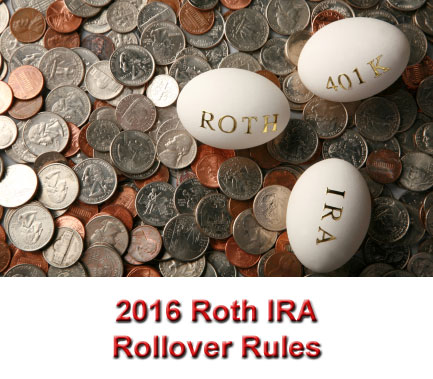 |
 |
|
|
2016 Roth IRA Rollover Rules
What are the 2016 Roth IRA rollover rules? If you're considering a Roth IRA rollover, you need to know. Why? Because as of January 2010, the rules dramatically changed for Roth IRA conversions. But before addressing the details of those rules, let's review the current Roth IRA rollover rules. To perform a successful rollover, you need to do the following things:
It's important to know each of these rules when performing a Roth IRA rollover, but the 2010 rule changes significantly altered this list, particularly the first bullet point - adjustable gross income (AGI) under the IRS limits. So let's focus on that.  Old Roth IRA Rollover Income LimitUnder the old rules, if you wanted to roll over funds from your 401k, Traditional IRA, 403b, or another qualified plan to your Roth IRA, you could only do so if your adjustable gross income (AGI) was no more than $100,000. This rule essentially prohibited people with six figure incomes from making Roth IRA conversions. If you once found yourself in this situation, you were out of luck when it came to making a Roth IRA conversion. However, in January 2010, your luck changed... Why? Because of modifications to the Roth IRA rollover rules in 2010. As January 2, 2010, anyone can make a Roth IRA conversion, regardless of income or tax filing status. 2016 Roth IRA Rollover Income LimitThe 2016 Roth IRA rollover rules keep in place the elimination of the $100,000 adjustable gross income (AGI) limit on making a Roth IRA conversion. The rules also eliminate the prohibition on conversions for married persons filing separate tax returns. So if you've missed out on the benefits of a Roth IRA in years past because of your income or tax filing status, 2016 offers you a great opportunity. For example, let's say you have a Traditional IRA worth $89,500, and your adjustable gross income (AGI) is $120,000. In 2016, you can perform a Traditional IRA rollover to a Roth IRA even though your AGI exceeds $100,000. Of course, whenever you perform a rollover, the odds are pretty good that you'll owe taxes, and that's an important subject for us to cover. Paying Taxes On A 2016 Roth IRA RolloverFor 2010 Roth IRA rollovers, the IRS provided you with the option to pay 50% of your tax bill in the first year, and 50% in the second year. But keep in mind, this only applied to conversions performed in 2010... If you perform a rollover in 2016, the taxes are due in 2016. The same is true for 2017 and beyond. So how are the taxes calculated? 2016 Roth IRA rollover taxes are calculated the same as any other rollover. Your tax bracket (using pre-rollover AGI) determines your tax rate, and that tax rate is applied to all taxable portions of your rollover distribution. For example, let's say you have a SIMPLE IRA worth $80,000, and you want to perform a rollover to a Roth IRA. Your current tax bracket is 30%. You owe $24,000 in taxes as a result of the rollover ($80,000 at 30%). This entire tax bill is due in 2016, so make sure you aren't misled by old rules from 2010 allowing you to pay the tax over a two year period. Regardless of your situation, it's best to consult a qualified accountant before making a Roth conversion to make sure you're aware of the potential complications so you can plan accordingly... Conversion Limit, NOT Contribution LimitEven though the $100,000 income limit on making a Roth IRA conversion expired in 2010, that doesn't mean that the income limit for making an annual Roth IRA contribution also expired. If you earn more than the Roth IRA phase out limits, then you can NOT make new contributions to your Roth IRA. So what are the limits? As of 2016, the maximum income limits for making a Roth IRA contribution are...
If your modified adjusted gross income (MAGI) exceeds the limit, you can NOT make a direct Roth IRA contribution for the current tax year. So remember, the 2016 Roth IRA rule changes do NOT effect the Roth IRA contribution limits. What they do effect is the $100,000 AGI limit on Roth IRA conversions. And that's where you see a sign of light if your income is too high to make a Roth IRA contribution. Why? Because thanks to the 2016 Roth IRA conversion rules, you can take advantage of a backdoor approach for making Roth IRA contributions. All you have to do is make non-deductible contributions to a Traditional IRA, then immediately convert your Traditional IRA to a Roth IRA. This effectively eliminates the income limit on making a Roth IRA contribution. Need an example? Let's say you're married, 38 years old, and earn $247,000 per year. For years, you've wanted to open and contribute to a Roth IRA, but you couldn't. Under current and future IRS rules, you're prohibited from making any direct contributions to a Roth IRA. Why? Because your modified adjusted gross income (MAGI) exceeds $194,000. But as long as you make non-deductible (after-tax) contributions, you don't have to worry about income limits restricting your ability to contribute to a Traditional IRA. As a result, you can fully fund your Traditional IRA to the tune of $5,500. Once you've done that, you can convert your Traditional IRA to a Roth IRA. And since you made contributions to your Traditional IRA with after-tax dollars, converting your IRA to a Roth IRA does NOT trigger a taxable event. That means your Traditional IRA funds simply roll over into your Roth IRA tax-free and penalty-free. And what does that mean? It means, for all intents and purposes, the income limits on making a Roth IRA contribution no longer exist. So if you're a high income earner, take advantage of the opportunities the 2016 Roth IRA rule changes offer! 2016 Roth IRA Rollover BenefitsSo now that you know the 2016 conversion rules, what are the benefits of a 2016 Roth IRA rollover? Depending on your personal financial situation, the benefits can be numerous. For instance, the new rules provide you with the opportunity to...
The latter point is especially significant. Why? Because unless Congress closes the loophole or reinstitutes the $100,000 income limit on Roth IRA conversions, it essentially eliminates the Roth IRA income limits. And unlike the 2010 tax deferral provision, this is something you can take advantage of year after year after year. So as of January 2010, anyone can open and fund a Roth IRA, regardless of income. ConclusionThe changeover to the 2016 Roth IRA rollover rules continues a significant change in the world of retirement planning that began in January 2010. If you've previously earned too much to meet the Roth IRA eligibility requirements, 2016 offers you the opportunity to establish, and continue contributing to, your own Roth IRA. While the Roth IRA income limits remain intact, the $100,000 limit on Roth IRA conversions is long gone, effectively eliminating any income caps on making a contribution.
Check out our new Facebook Page and follow us on Twitter!
Return to the top of 2016 Roth IRA Rollover Return to 2016 Roth IRA Limits Return to the Your Roth IRA Website Homepage
|
What's New?Read 5 Reasons Why I Love My Roth IRA, our part in the Good Financial Cents Roth IRA Movement! Start planning ahead for next year by checking out 2017 Roth IRA contribution limits, and stay alert to this year's changes to the 2016 Roth IRA contribution limits. Our family fully funds our Roth IRA with this website. Learn how you can do it too. Are you confused or frustrated by the stock market? Learn how to build real wealth selecting individual stocks for your Roth IRA... Read more about what's new on the Roth IRA blog. Hi, I'm Britt, and this is my wife, Jen. Welcome to our Roth IRA information website! This is our humble attempt to turn a passion for personal finance into the Web's #1 resource for Roth IRA information. But, believe it or not, this site is more than just a hobby. It's a real business that provides a stable and steady stream of income for our family. In fact, because of this site, Jen is able to be a full-time stay-at-home mom and spend more time with our daughter, Samantha. But you want to know the best part? ...You can do the same thing! Anyone with a hobby or a passion (even with no previous experience building a website) can create a profitable site that generates extra income. If you're tired of solely depending on your job(s) for family income, click here now and learn why our income is increasing despite the financial crisis and how we're making our dreams come true. |
|
Search This SiteRoth IRA BasicsMore About Roth IRAsRoth IRA ResourcesAbout Your Roth IRALike Us On FacebookFollow Us On Twitter
RSSDisclaimerThe information contained in Your Roth IRA is for general information purposes only and does not constitute professional financial advice. Please contact an independent financial professional when seeking advice regarding your specific financial situation. For more information, please consult our full Disclaimer Policy as well as our Privacy Policy. Thank YouOur family started this site as a labor of love in February 2009, a few months after our daughter was born. Thank you for helping it become one of the most visited Roth IRA information sites. Thank you, too, to the "SBI!" software that made it all possible. We hope you find what you're looking for and wish you much continued success in your retirement planning! |
||
|
| ||






